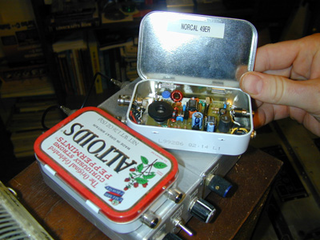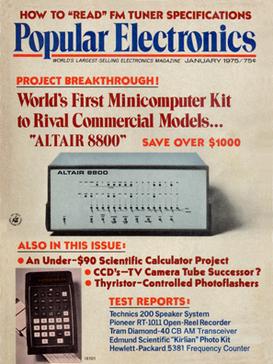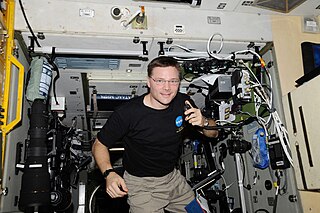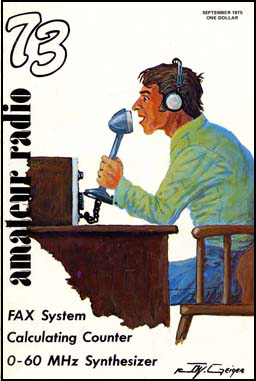Stanley Gibilisco (1955 - 3 May 2020) [1] was a nonfiction writer. He authored books in the fields of electronics, general science, mathematics, and computing.
Gibilisco began his career in 1977 as a radio technician and editorial assistant at the headquarters of the American Radio Relay League in Newington, Connecticut. Later he worked as a radio-frequency design engineer and technical writer for industry.
In 1982, Stan began writing for TAB Books with editorial offices in Blue Ridge Summit, Pennsylvania. One of the books that he compiled for TAB, the Encyclopedia of Electronics, was named by the American Library Association (ALA) in its list of "Best References of the 1980s." Another of his books, the McGraw-Hill Encyclopedia of Personal Computing, was named as a "Best Reference of 1996" by the ALA.
Stan produced instructional, technical, and general interest videos on YouTube. Subjects include electronics, computers, physics, mathematics, alternative energy, and amateur radio.
Stan lived in Lead, South Dakota, home of the Sanford Underground Research Facility. He was an active amateur radio operator and used the call sign W1GV. [2] He died on 3 May 2020 in Lead, SD.

In amateur radio, QRP operation refers to transmitting at reduced power while attempting to maximize one's effective range. QRP operation is a specialized pursuit within the hobby that was first popularized in the early 1920s. QRP operators generally limit their transmitted RF output power to 5 Watts or less regardless of mode be it CW operation or SSB operation.
The early history of radio is the history of technology that produces and uses radio instruments that use radio waves. Within the timeline of radio, many people contributed theory and inventions in what became radio. Radio development began as "wireless telegraphy". Later radio history increasingly involves matters of broadcasting.

AM broadcasting is radio broadcasting using amplitude modulation (AM) transmissions. It was the first method developed for making audio radio transmissions, and is still used worldwide, primarily for medium wave transmissions, but also on the longwave and shortwave radio bands.

Pirate radio or a pirate radio station is a radio station that broadcasts without a valid license.
The American Radio Relay League (ARRL) is the largest membership association of amateur radio enthusiasts in the United States. ARRL is a non-profit organization, and was co-founded on April 6, 1914, by Hiram Percy Maxim and Clarence D. Tuska of Hartford, Connecticut. The ARRL represents the interests of amateur radio operators before federal regulatory bodies, provides technical advice and assistance to amateur radio enthusiasts, supports a number of educational programs and sponsors emergency communications service throughout the country. The ARRL has approximately 161,000 members. In addition to members in the US, the organization claims over 7,000 members in other countries. The ARRL publishes many books and a monthly membership journal called QST.

Popular Electronics was an American magazine published by John August Media, LLC, and hosted at TechnicaCuriosa.com. The magazine was started by Ziff-Davis Publishing Company in October 1954 for electronics hobbyists and experimenters. It soon became the "World's Largest-Selling Electronics Magazine". In April 1957 Ziff-Davis reported an average net paid circulation of 240,151 copies. Popular Electronics was published until October 1982 when, in November 1982, Ziff-Davis launched a successor magazine, Computers & Electronics. During its last year of publication by Ziff-Davis, Popular Electronics reported an average monthly circulation of 409,344 copies. The title was sold to Gernsback Publications, and their Hands-On Electronics magazine was renamed to Popular Electronics in February 1989, and published until December 1999. The Popular Electronics trademark was then acquired by John August Media, who revived the magazine, the digital edition of which is hosted at TechnicaCuriosa.com, along with sister titles, Mechanix Illustrated and Popular Astronomy.

Forrest M. Mims III is an American amateur scientist, magazine columnist, and author of Getting Started in Electronics and Engineer's Mini-Notebook series of instructional books that were originally sold in Radio Shack electronics stores and are still in print. Mims graduated from Texas A&M University in 1966 with a major in government and minors in English and history. He became a commissioned officer in the United States Air Force, served in Vietnam as an Air Force intelligence officer (1967), and a Development Engineer at the Air Force Weapons Laboratory (1968–70).
Frederick Charles Judd was a British inventor, amateur radio operator, and proselytiser of early British electronic music.

An electronic symbol is a pictogram used to represent various electrical and electronic devices or functions, such as wires, batteries, resistors, and transistors, in a schematic diagram of an electrical or electronic circuit. These symbols are largely standardized internationally today, but may vary from country to country, or engineering discipline, based on traditional conventions.

An amateur radio operator is someone who uses equipment at an amateur radio station to engage in two-way personal communications with other amateur operators on radio frequencies assigned to the amateur radio service. Amateur radio operators have been granted an amateur radio license by a governmental regulatory authority after passing an examination on applicable regulations, electronics, radio theory, and radio operation. As a component of their license, amateur radio operators are assigned a call sign that they use to identify themselves during communication. About three million amateur radio operators are currently active worldwide.
The Shuttle Amateur Radio Experiment (SAREX), later called the Space Amateur Radio Experiment, was a program that promoted and supported the use of amateur ("ham") radio by astronauts in low earth orbit aboard the United States Space Shuttle to communicate with other amateur radio stations around the world. It was superseded by the Amateur Radio on the International Space Station (ARISS) program. SAREX was sponsored by NASA, AMSAT, and the ARRL.

73 Magazine was a United States-based amateur radio magazine that was published from 1960 to 2003. It was known for its strong emphasis on technical articles and for the lengthy editorials in each issue by its founder and publisher, Wayne Green. The magazine title, 73, means "best regards" in amateur radio lingo.
In electronics, cathode bias is a technique used with vacuum tubes to make the direct current (dc) cathode voltage positive in relation to the negative side of the plate voltage supply by an amount equal to the magnitude of the desired grid bias voltage.

Rufus Paul Turner was an academic, engineer, and author who published on semiconductor devices, technical writing style, and poet-novelist Charlotte Smith. After three decades working with electronic devices – including developing the first practical transistor radio – he earned a doctorate in literature at age 52 and became an English professor. He wrote over 40 books and 3000 articles during his six-decade career.

Amateur radio, also known as ham radio, is the use of the radio frequency spectrum for purposes of non-commercial exchange of messages, wireless experimentation, self-training, private recreation, radiosport, contesting, and emergency communications. The term "amateur" is used to specify "a duly authorized person interested in radioelectric practice with a purely personal aim and without pecuniary interest;" and to differentiate it from commercial broadcasting, public safety, or professional two-way radio services.

Radio-Electronics was an American electronics magazine that was published under various titles from 1929 to 2003. Hugo Gernsback, sometimes called the father of science fiction, started it as Radio-Craft in July 1929. The title was changed to Radio-Electronics in October 1948 and again to Electronics Now in July 1992. In January 2000 it was merged with Gernsback's Popular Electronics to become Poptronics. Gernsback Publications ceased operations in December 2002 and the January 2003 issue was the last. Over the years, Radio-Electronics featured audio, radio, television and computer technology. The most notable articles were the TV Typewriter and the Mark-8 computer. These two issues are considered milestones in the home computer revolution.
This article details the history of electronics engineering. Chambers Twentieth Century Dictionary (1972) defines electronics as "The science and technology of the conduction of electricity in a vacuum, a gas, or a semiconductor, and devices based thereon".
Francis George Rayer T.Eng.(CEI). Assoc.IERE was a British science fiction writer and technical journalist.
TAB is an imprint of McGraw-Hill Education, based in New York, New York, that publishes do-it-yourself technology books for makers, electronics hobbyists, students, and inventors.
WSAJ was one of the earliest AM educational radio stations, licensed November 29, 1922 – January 30, 2006 to Grove City College in Grove City, Pennsylvania. The station traced its founding to broadcasts made over "Technical and Training School" station 8YV, which began in March 1920.